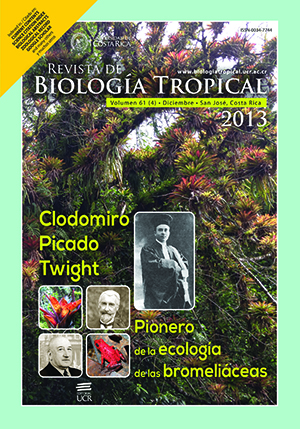Abstract
In Argentina, no ecological studies have been reported on the infection parameters of Kalipharynx sp. metacercariae in planorbid snails. To this end, the aims of this study were: (i) to provide information on the population biology of Kalipharynx sp. metacercariae in the planorbid snails Biomphalaria tenagophila and B. occidentalis through the study of prevalence and intensity of larval infection during a seasonal cycle; (ii) to evaluate the effects of host shell size on prevalence and infection intensity, (iii) to evaluate the effect of infection intensity on cyst size. Samples were taken between June 2010 and April 2011 (encompassing all seasons) from a subtropical permanent pond in Corrientes City, Corrientes, Argentina. A total of 362 metacercariae (n=262 and n=100; from B. tenagophila and B. occidentalis respectively) were collected from 616 snails (n=466 and n=150 from B. tenagophila and B. occidentalis respectively). The metacercarial cysts were found in the digestive gland, mantle cavity, intestine and ovotestis. B. tenagophila showed a range of infection from 1 to 60 cysts per snail (mean=4.5±SD=9.9), and cyst diameter ranging between 255 and 705μm (466.4±119); while, B. occidentalis showed a range of infection from 1 to 23 (5.5±5.6), and cyst diameter ranging between 310 to 900μm (554.5±150). Results obtained indicated that, although absent in autumn, metacercariae of Kalipharynx sp. were present most of the year in both species of Biomphalaria, showing high values in both warm-season. Furthermore, both the infection intensity and host shell size varied significantly between seasons, although no seasonal variation was observed with respect to metacercarial cyst size, suggesting the possibility of more than one peak of cercariae emergence during the year. The prevalence of infection was significantly and positively correlated with snail size in both host species (p<0.05). The smallest host size class harbouring a metacercarial infection was 7.1-8.0mm and 11.1-12.0mm in B. tenagophila and B. occidentalis, respectively. The mean intensity of infection was positively correlated with snail size, but this relation was significant only in B. tenagophila (p<0.05). However, non-significant negative correlations were observed for intensity of infection vs cyst size in both host species (p>0.05). The results of this study show a significant influence of host size on prevalence and infection intensity, and a tendency towards density-dependent reductions in the growth of cysts. This is the first study in Argentina analyzing the population biology of Kalipharynx sp. metacercariae.##plugins.facebook.comentarios##
Downloads
Download data is not yet available.






